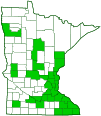birdfoot violet
(Viola pedata)
Conservation • Wetland • Description • Habitat • Ecology • Use • Distribution • Taxonomy
Description |
||
Birdfoot violet is a 3″ to 6″ tall, erect, perennial forb that rises from an erect, tuberous caudex and fibrous roots. The leaves are all basal, rising from the rootstock on hairless leaf stalks. Outer leaves are on stalks up to 1″ long, inner leaves on stalks up to 2″ long. Outer leaves are about ¾″ wide, ⅝″ long, and palmately divided into 3 deeply cut segments. The lateral segments are again divided into 3 to 5 narrowly inversely egg-shaped or inversely lance-shaped lobes. The lobes may have 2 to 4 deeply cut teeth near the tip. Inner leaves are about 1½″ wide, 1″ long, and palmately divided into 3 or 5 deeply cut segments. The segments may be again divided into 3 to 7 secondary lobes. The lobes are linear or inversely lance-shaped. Both types of leaves are hairless or nearly hairless. The margins have a fringe of minute, stiff, appressed hairs. There is no central stem. The inflorescence is a single flower at the end of a hairless, leafless, often purplish stalk. The stalk is at least as long as the leaf stalks and may be up to 4″ long. The flowers are ¾″ to 1½″ wide. The 5 petals are usually lilac purple, though the upper 2 petals are sometimes dark violet. The 2 lateral petals do not have tufts of hairs near the throat. The lower petal fades to white with purple veins near the throat, and has a hooked, rounded spur at the base. The 5 stamens are orange, conspicuously protruding, and converging, but not fused, around the ovary. Self-polinating (cleistogamous) flowers are not produced. The fruit is a ¼″ to ⅓″ long, hairless, yellowish-brown capsule. |
||
Height |
||
3″ to 6″ |
||
Flower Color |
||
Lilac purple |
||
Similar Species |
||
| Birdfoot violet is easily identified by the deeply lobed leaves, unbearded lateral petals, and conspicuous, protruding, orange stamens. | ||
Habitat |
||
Dry. Woods, prairies. Full to partial sun. |
||
Ecology |
||
Flowering |
||
April to June |
||
Pests and Diseases |
||
|
||
Use |
||
|
||
Distribution |
||||
|
Sources |
|||
| 2/20/2023 | ||||
Nativity |
||||
Native |
||||
Occurrence |
||||
|
||||
Taxonomy |
|||
| Kingdom | Plantae (Plants) | ||
| Subkingdom | Pteridobiotina | ||
| Phylum | Tracheophyta (Vascular Plants) | ||
| Class | Magnoliopsida (Dicots) | ||
Order |
Malpighiales (Nances, Willows, and Allies) | ||
Family |
Violaceae (violet) | ||
| Subfamily | Violoideae | ||
| Tribe | Violeae | ||
| Genus | Viola (violets) | ||
| Subgenus | Viola (pansies and violets) | ||
| Section | Nosphinium | ||
| Subsection | Pedatae (bird’s foot violets) | ||
Synonyms |
|||
Viola pedata var. concolor Viola pedata var. lineariloba Viola pedata var. ranunculifolia |
|||
Common Names |
|||
beardless birdfoot violet birdfoot violet |
|||
Glossary
Bearded
Bearing one or more tufts of hairs.
Caudex
A short, thickened, woody, persistent enlargement of the stem, at or below ground level, used for water storage.
Cleistogamous
Automatically self-pollinating. Refers to bud-like flowers that do not open but automatically self-pollinate, or to plants with such flowers.
Linear
Long, straight, and narrow, with more or less parallel sides, like a blade of grass.
Palmate
Similar to a hand. Having more than three lobes or leaflets that radiate from a single point at the base of the leaf.
Visitor Photos |
|||||
Share your photo of this plant. |
|||||
| This button not working for you? Simply email us at info@MinnesotaSeasons.com. Attach one or more photos and, if you like, a caption. |
|||||
Nancy Falkum |
|||||
Birds Foot Violet |
|||||
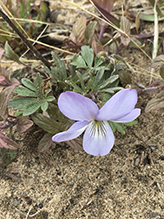 |
|||||
Bird’s Foot Violet, Hairy Puccoon, and Lyre Leaved Rock Cress |
|||||
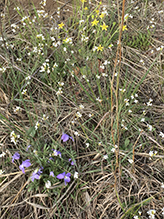 |
|||||
MinnesotaSeasons.com Photos |
|||||
Plant |
|||||
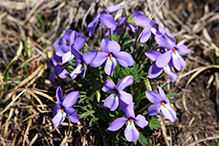 |
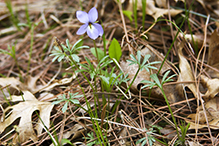 |
||||
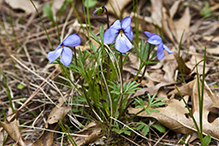 |
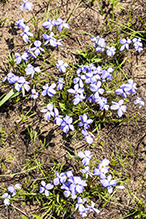 |
||||
Flower |
|||||
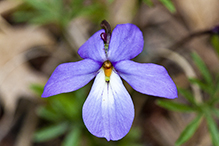 |
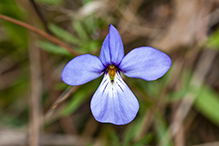 |
||||
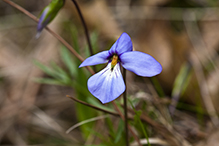 |
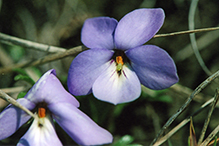 |
||||
Leaves |
|||||
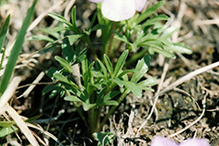 |
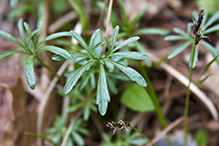 |
||||

Slideshows |
||

Visitor Videos |
|||
Share your video of this plant. |
|||
| This button not working for you? Simply email us at info@MinnesotaSeasons.com. Attach a video, a YouTube link, or a cloud storage link. |
|||
Other Videos |
|||
| Native bee on Viola pedata Retha Meier |
|||
About
Published on Jul 23, 2014 This video was recorded at our research site at Cuivre River State Park, just outside of Troy, Missouri. Andrena carlini, the most common visitor to our Cuivre River population, inverts its body to forage on Viola pedata. The occurrence of the two color morphs of V. pedata is approximately 50/50 at this site. |
|||
| Viola pedata bicolor with bee Retha Meier |
|||
About
Published on Jul 24, 2014 Note how the native bee positions itself on the Viola pedata. |
|||

Visitor Sightings |
|||||
Report a sighting of this plant. |
|||||
| This button not working for you? Simply email us at info@MinnesotaSeasons.com. Be sure to include a location. |
|||||
| Nancy Falkum 4/24/2021 |
Location: Kellogg Weaver Dunes SNA, Weaver Dunes Unit Birds Foot Violet |
 |
|||
| Nancy Falkum 5/9/2017 |
Location: Kellogg Weaver Dunes SNA, Weaver Dunes Unit Bird’s Foot Violet, Hairy Puccoon, and Lyre Leaved Rock Cress |
 |
|||
MinnesotaSeasons.com Sightings |
|||||

|
Created: Last Updated: © MinnesotaSeasons.com. All rights reserved. |
